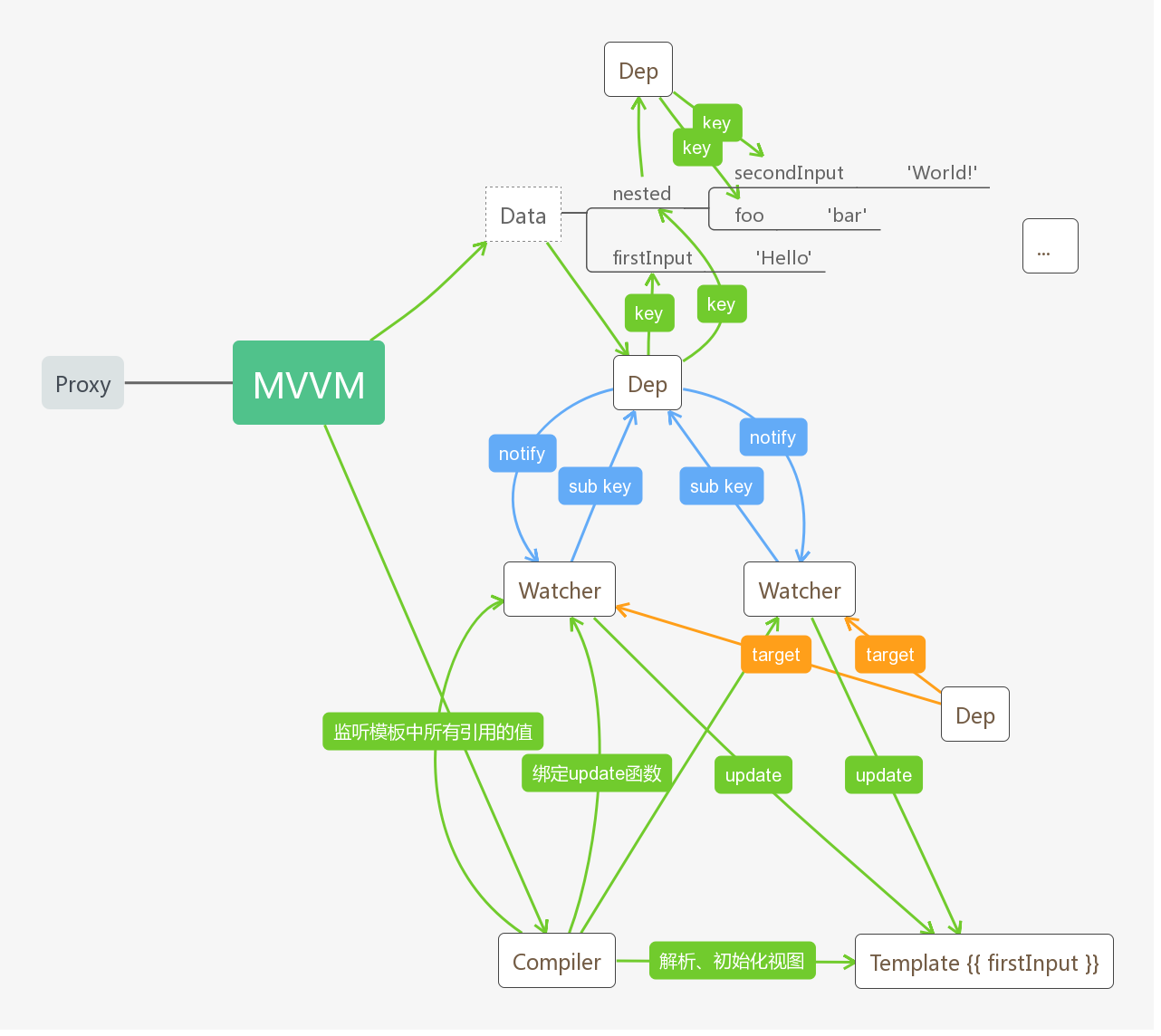上一篇实现 MVVM 数据劫持是基于 ES5 的 Object.defineProperty() API,新的轮子将使用 Proxy 替代,follow Vue 3;在原有轮子的基础上做些改造,适配 Proxy。
Object.defineProperty() 和 Proxy 实现 MVVM 数据劫持的区别是:Object.defineProperty() 需要为每个 key 定义 getter 和 setter,也就是需要遍历 data 下的全部子属性;而 Proxy 只需要为 data 本身和内部嵌套的对象创建代理,每个对象统一代理访问内部属性,对外提供代理的引用。
MVVM Proxy 原理实现
效果(同上一个轮子):
index.html 和 Compiler 模块不需要改动,详情见 上一篇
MVVM 模块
MVVM 初始化时需要代理 this.xxx 到 this.$data.xxx 或者 options.computed.xxx,所以给 this 创建一个 Proxy 代理,判断 key 在 this 本身、data、methods、computed 中,分别通过 Reflect.get() 在对应的 object 上获取 key 值。
1
2
3
4
5
6
7
8
9
10
11
12
13
14
15
16
17
18
19
20
21
22
23
24
25
26
27
|
_proxyThis() {
const { $options } = this
const { computed } = $options
return new Proxy(this, {
get(target, key, receiver) {
// 访问 MVVM 实例属性
if (key in target) return Reflect.get(target, key, receiver)
// 访问 data 属性
if (key in $options.data)
return Reflect.get(target.$data, key, receiver)
// 访问 method
if (key in $options.methods)
return Reflect.get($options.methods, key, receiver)
// 访问 computed 属性
return typeof computed[key] === 'function'
? computed[key].call(target._vm)
: Reflect.get(computed, key, receiver)
},
set(target, key, value, receiver) {
// 设置 data 属性
if (!target[key]) {
return Reflect.set(target.$data, key, value, receiver)
}
return Reflect.set(target, key, value, receiver)
},
})
}
|
new Proxy(this, handler) 创建的 this 代理需要作为 MVVM 构造函数的实例对象返回,因为提供给外部访问的是代理,即 this._vm:
1
2
3
4
5
6
|
constructor(options = {}) {
// ...
this._vm = this._proxyThis()
// ...
return this._vm
}
|
然后将 methods 函数中的 this 绑定到 this._vm 上:
1
2
3
4
5
6
|
_bindMethods() {
const methods = this.$options.methods
Object.keys(methods).forEach(method => {
methods[method] = methods[method].bind(this._vm)
})
}
|
调用 Observer 给 options.data 和嵌套对象创建代理:
1
|
this.$data = observe(options.data)
|
最后还是一样调用 Compiler 解析模板:
1
|
this.$compile = new Compiler(options.el || document.body, this._vm)
|
Dep 模块
Dep 模块存储结构跟上个轮子的 Dep 不同,因为使用 Proxy 代理后,只能为每个对象绑定一个 Dep 实例,一个 Dep 实例包含该对象内部所有属性的订阅者,而不是之前的一个属性一个 Dep 实例。
为了保证存储订阅者的数据结构的唯一性,使用 Set 结构保证订阅者不会重复;外层使用 Map 结构存储 key - Set 的映射关系。
订阅中心提供的每个接口,都需要 key 和 sub 参数,根据 key 找出 Map 中映射的 Set,在订阅者 Set 中进行操作。
Observer 模块
Observer 模块使用 Proxy 代理 data 中嵌套对象的访问。
导出的 observe 函数递归遍历 data 内部属性,遇到对象就创建一个 Proxy 覆盖原始对象值,最后返回 data 对象的代理:
1
2
3
4
5
6
7
8
9
10
11
12
|
export function observe(data) {
// data 不是对象无法劫持,忽略
if (!data || typeof data !== 'object') {
return data
}
// 深度监听
Object.keys(data).forEach(key => {
data[key] = observe(data[key])
})
return Observer(data)
}
|
proxyObject 函数为 data 中的每个嵌套对象创建代理和绑定的 Dep 实例。跟上个轮子不同,在 getter 中,这里简化了添加订阅者的逻辑,如果判断 Dep.target 存在,直接通过闭包在绑定的 Dep 实例上把订阅该 key 的 Watcher 实例添加到订阅者中。
1
2
3
4
5
6
7
8
9
10
11
12
13
14
15
16
17
18
19
20
|
const proxyObject = obj => {
const dep = new Dep()
return new Proxy(obj, {
get: function(target, key, receiver) {
// 如果订阅者存在,直接添加订阅
if (Dep.target) {
dep.addSub(key, Dep.target)
}
return Reflect.get(target, key, receiver)
},
set: function(target, key, value, receiver) {
if (Reflect.get(receiver, key) === value) {
return
}
const res = Reflect.set(target, key, observe(value), receiver)
dep.notify(key)
return res
},
})
}
|
Watcher 模块
因为添加订阅者的逻辑已经在 Observer 模块做了,所以 Watcher 模块删除了 applyDep() 方法,其它不变:
1
2
3
4
5
6
|
// applyDep(dep) {
// if (!this.depIds.hasOwnProperty(dep.id)) {
// dep.addSub(this)
// this.depIds[dep.id] = dep
// }
// }
|
新的模块关系图

总结
Vue 3.0 使用了 Proxy 后,将会消除之前 Vue 2.x 中基于 Object.defineProperty 的实现所存在的一些限制:无法监听 属性的添加和删除、数组索引值和长度的变更。
GitHub 地址:https://github.com/Jancat/vue-mvvm-proxy
参考
https://github.com/xiaomuzhu/proxy-vue
